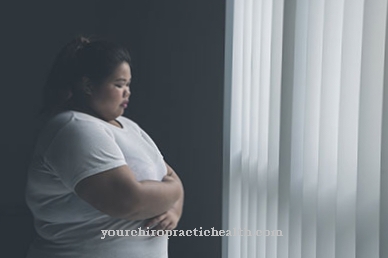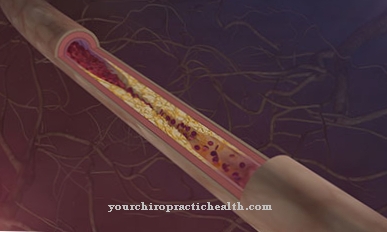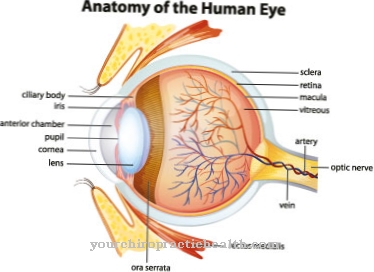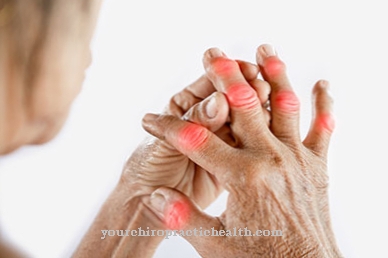The Bardet-Biedl syndrome, also Laurence-Moon-Biedl-Bardet syndrome (LMBBS), is a disease from the field of ciliopathies that occurs exclusively due to heredity. The syndrome manifests itself in the form of multiple malformations that are triggered by changes (mutations) on different gene locations or chromosomes.
What is Bardet-Biedl Syndrome?

© Creativa Images - stock.adobe.com
The clinical picture defined by the physicians Moon and Laurence and later by Bardet and Biedl is a disease in which retinal dystrophy occurs as a medically significant feature in combination with other symptoms. Due to this complicated medical initial situation, the final determination of the BBS disease is difficult. This clinical picture was medically recorded for the first time in 1866.
Four people examined had retinitis pigmentosa (retinal dystrophy, RP) in conjunction with paraplegia (spastic paralysis) as well as hypogenitalism (underdeveloped genital organs) and a mental handicap. In 1920 the French physician Bardet described a disease that was composed of RP (retinal dystrophy), hypogenitalism, polydactyly and obesity.
The Prague pathologist Biedl also found debility (mental confusion). In 1925 the researchers Weiss and Solis-Cohen summarized the known cases and described the clinical picture as Laurence-Moon-Biedl-Bardet syndrome.
causes
In the years that followed, the medical literature increasingly pointed out that the cases recorded by Laurence and Moon are a rare special form that only occurs in individual cases together with BBS. More recent medical research results assign the Bardet-Biedl syndrome to the area of ciliopathies (ciliary diseases).
These diseases show a common malfunction of the so-called cilia (small processes, antennae), which occur on the majority of cells of the human organism. The ciliopathies are characterized by flowing transitions and overlaps between different ciliary diseases.
Symptoms, ailments & signs
The main characteristic of hereditary retinal dystrophy is a generic term that describes the onset of loss of function and the subsequent degeneration (destruction) of the photoreceptors. They lead to a progressive (progressive) loss of visual function. The rapidly progressing visual disturbances usually appear very early in children when they are between four and ten years old. They make themselves felt in different ways, depending on the photoreceptors affected.
As a "rod-cone shape" with the characteristic course of retinitis pigmentosa (RP), the disease has its origin in the retinal periphery (outer retina) and develops into macular degeneration (destruction of sharp eyesight) via a progressive loss of field of view.
With obesity (obesity), the body shows a pathological accumulation of fatty tissue. In the case of BBS, abnormally increased accumulations of fat on the legs, stomach, buttocks, arms, chest and hips mainly occur as trunk obesity, with the trunk, legs and thighs being particularly badly affected. Polydactyly is a noticeable symptom and a significant feature of Bardet-Biedl syndrome. The finding is not easy because the rudimentary polydactyly is corrected surgically after birth.
X-rays are able to provide further information. Polydactyly can appear with different signs, for example as a rudimentary toe or finger appendage. A toe or finger can be formed additionally or only partially. The unilateral hexadactyly on the foot and / or hand has an additional link, the bilateral hexadactyly occurs on both feet and / or hands.
Toes or fingers that have grown together (syndactyly) and shortening of one or more toes or fingers (brachydactyly) are also signs of BBS. Only a few patients have all four affected extremities. The mental development delay is different. Only a small number of those affected show severe mental retardation. A normally trained intelligence is possible.
Children learn to speak and walk late, and they sometimes show behavioral problems such as anxiety disorders. Compulsive or autistic behaviors, a low threshold for frustration, and unstable emotionality are other possible side effects. The familiar is preferred, but changes are rejected. Abnormalities in the internal and external genital organs are common.
Other changes are hypospadias (the urethral opening is above or below, instead of on the front of the penis), abdomen or inguinal testicles, urethral constrictions, foreskin constriction and posterior urethral valves. In female patients, vaginal atresia (vagina is not open through), missing urethral openings and reduced inner labia are known.
It is not uncommon for the women affected to have irregular menstrual cycles. Kidney changes are common side effects. The finding depends on the examination of the lower urinary tract and the kidneys using ultrasound (sonography).
Diagnosis & course of disease
Bardet-Biedl syndrome (BBS) has six main symptoms, but they do not occur together in every case. Doctors assume a corresponding finding if at least four of the main symptoms are present. Alternatively, there is a high probability that the disease is present if the patient has three main symptoms and two secondary symptoms.
The six main symptoms are retinal dystrophy, obesity (abnormal accumulation of adipose tissue, being overweight), polydactyly (excess toes and / or fingers), mental retardation (mental developmental delay), hypogenitalism (underdeveloped genital organs) and kidney disease. Low-frequency secondary symptoms include speech delays, speech deficits, cardiac malformations, ataxia (impaired movement coordination), asthma, diabetes mellitus (diabetes), Crohn's disease (inflammation of the large and / or small intestine), dysplasia of the ribs and vertebrae, and kyphoscoliosis (vertebral anemia) on.
Complications
With Laurence-Moon-Biedl-Bardet syndrome, those affected usually suffer from a loss of visual function. The loss does not occur suddenly, but gradually. In the worst case, those affected will go completely blind, which can usually no longer be treated.
Especially in young people and children, blindness can lead to severe psychological complaints or even depression. The patients are clearly restricted in their everyday life and suffer from a greatly reduced field of vision. In many cases, Laurence-Moon-Biedl-Bardet syndrome also leads to behavioral problems, so that children in particular can suffer from bullying or teasing.
The development of children is also significantly delayed and restricted by the syndrome. Anxiety disorders can also occur. It is not uncommon for Laurence-Moon-Biedl-Bardet syndrome to lead to psychological complaints and depression in relatives or parents. A causal treatment of Laurence-Moon-Biedl-Bardet syndrome is unfortunately not possible.
Some complaints can be limited. A completely positive course of the disease does not set in, however. The syndrome does not reduce the patient's life expectancy. In some cases, those affected sometimes need help from other people in their everyday lives.
When should you go to the doctor?
Since Laurence-Moon-Biedl-Bardet syndrome is a hereditary disease, the diagnosis can be made in the womb. At the latest after the birth, a doctor should be consulted if typical symptoms such as visual disturbances or obesity are noticed. Malformations of the toes and fingers are also a clear indicator of a disease.Parents who notice symptoms in their child should inform the pediatrician immediately.
A comprehensive examination provides information about the disease. Thereafter, therapy is usually initiated directly, which consists of various treatments by orthopedists, neurologists, ophthalmologists, internists and therapists as well as physiotherapists. Further visits to the doctor are necessary if the treatment does not have the desired effect. Medical advice is also required in emergency situations, for example if the child falls as a result of a malformation or suddenly has a seizure. If the sick person shows signs of emotional discomfort, the parents must consult a suitable therapist. Older children can contact the school psychologist together with their parents and discuss suitable measures.
Therapy & Treatment
This disease occurs on the basis of autosomal recessive inheritance, which means that both copies (alleles) of a BBS gene show a change (mutation). The patient's parents are “mixed-blooded” and each carry a modified and an unchanged allele of the corresponding gene. They do not have the disease. Children only get sick if their father and mother pass on the mutated allele. With additional children, the probability of repetition is 25 percent.
A causal therapy option is not yet known, as certain symptoms of the disease cannot yet be conclusively assigned to the various genetic changes. The symptoms and their manifestations appear differently even in sick siblings. Since the characteristic full picture of BBS is only present in rare cases, especially in small children, a corresponding diagnosis is difficult.
Due to the frequently present oligosymptomatics, with which very few atypical and only slightly pronounced symptoms occur, other possible clinical pictures must be taken into account in the differential diagnosis. Changes in the same gene can lead to different clinical pictures, for example Joubert, Bardet-Biedl or Meckel-Gruber syndrome.
Outlook & forecast
The prognosis for the presence of Laurence-Moon-Biedl-Bardet syndrome is generally poor because the multiple malformations are congenital and incurable. If four of the six main symptoms occur, the diagnosis of Laurence-Moon-Biedl-Bardet syndrome is confirmed. Numerous secondary symptoms add to the main symptoms. This includes a creeping blindness.
It is due to the complexity of the symptoms that there is no prospect of a cure. There is only a mediocre chance of noticeable symptom relief. The number of possible malformations and disorders in Laurence-Moon-Biedl-Bardet syndrome is so great that the hereditary disease is difficult to treat. In any case, the course of this genetic disease cannot be influenced. However, the present symptoms can be partially alleviated.
However, the poor overall prognosis does not reduce the life expectancy of the people affected. At an advanced age and after going blind, those affected can be permanently dependent on help or care. Through interdisciplinary medical efforts, many sufferers with Laurence-Moon-Biedl-Bardet syndrome can experience a somewhat milder course of the disease.
The increasing visual problems represent a difficult to treat and problematic part of the disease. Increasing visual impairments already occur in the affected small children. They worsen over time. The vision problems do not have to lead to blindness in all those affected. The psychological sequelae of Laurence-Moon-Biedl-Bardet syndrome can usually be treated well.
prevention
Prevention in the sense of preventing this disease is not possible. Regular monitoring of the symptoms and accompanying symptoms is important. Repeated checks of blood pressure and kidney function, nutritional advice, physiotherapy and occupational therapy as well as speech therapy are possible therapeutic approaches.
Aftercare
In most cases, those affected with Laurence-Moon-Biedl-Bardet syndrome have no special follow-up options available, so that a doctor should be contacted and consulted very early on in this disease. As a rule, self-healing cannot occur, so treatment by a doctor is always necessary.
Since Laurence-Moon-Biedl-Bardet syndrome is a hereditary disease, the person concerned should have a genetic examination and advice carried out if they wish to have children so that Laurence-Moon-Biedl-Bardet syndrome does not pass to their offspring is passed on. In many cases, those affected depend on surgical interventions to alleviate the malformations and deformities.
Here, the person affected should definitely rest after the procedure and take care of their body. Exertion or other physical and stressful activities should be avoided in any case in order not to unnecessarily burden the body. Since Laurence-Moon-Biedl-Bardet syndrome can also lead to abnormal behavior, parents should support and encourage the child in development. Loving and intensive discussions with the child are also necessary in order to prevent psychological upsets or depression.
You can do that yourself
Laurence-Moon-Biedl-Bardet syndrome has various symptoms, with the patient often suffering most from impaired visual function. Even with children, the usual ability to see begins to deteriorate, so that it is the parents who present the child to a doctor and thus speed up the diagnosis. In this way, the disease can be treated quickly, although the treatment options have so far only been symptomatic in nature.
The visual disturbances increase increasingly in the sick children and thus impair everyday life considerably, so that the quality of life of those affected decreases. Because the vision problems develop numerous difficulties for the patient when attending school, in their free time and with regard to their physical integrity. The risk of accidents also increases significantly, for example in road traffic. That is why parents accompany their sick children whenever possible or hire nursing staff so that the patient is not left to fend for himself.
In some cases, the disease spreads to the point of blindness. Since such a development is already evident beforehand, patients prepare for it. The parents redesign the living space so that it does not contain any sources of danger for the visually impaired person. In addition, the blind victims learn how to use a long stick so that they can move independently outside their own home.














.jpg)













